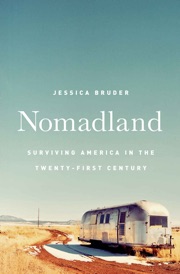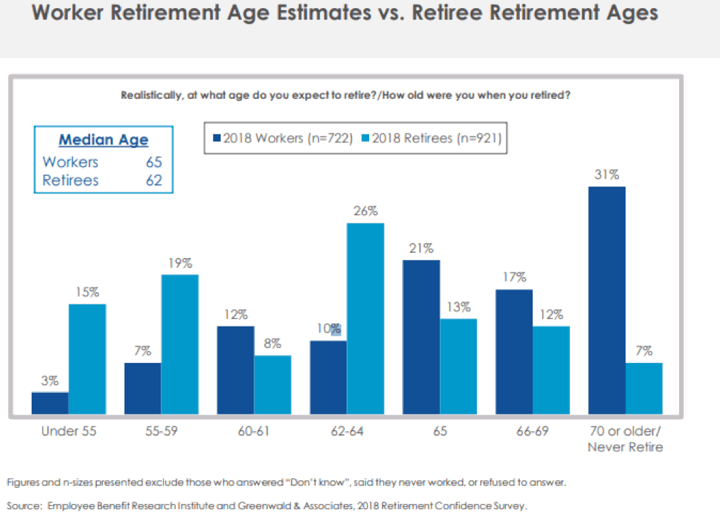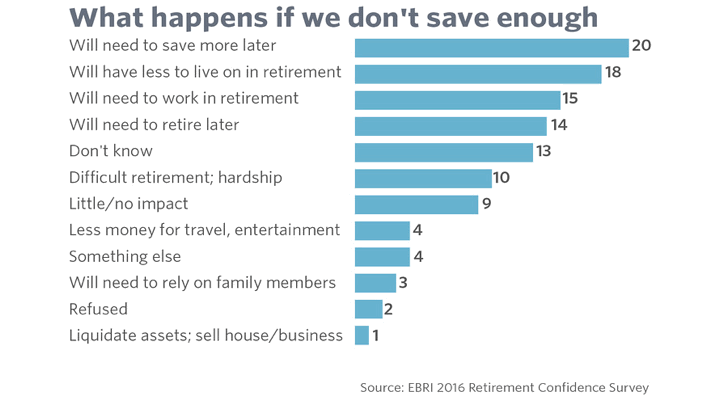 I’m reading Nomadland: Surviving America in the Twenty-First Century by Jessica Bruder. Essentially, it’s the story what happens to a group of people when their plans for retirement fall apart. Here’s the book blurb:
I’m reading Nomadland: Surviving America in the Twenty-First Century by Jessica Bruder. Essentially, it’s the story what happens to a group of people when their plans for retirement fall apart. Here’s the book blurb:
From the beet fields of North Dakota to the campgrounds of California to Amazon’s CamperForce program in Texas, employers have discovered a new, low-cost labor pool, made up largely of transient older adults. These invisible casualties of the Great Recession have taken to the road by the tens of thousands in RVs and modified vans, forming a growing community of nomads.
You’ll probably retire earlier than you expect. Consider this EBRI chart showing the big difference between when workers expect they will retire (dark blue) and when people actually retired (light blue). One-third (34%) of all workers ended up “retired” by the time they reached 60, but the majority didn’t see it coming (which I assume means it was mostly involuntary).

Going through the book, here is a rough breakdown of the stages that the people went through:
Plan A: Ideal retirement. You have plenty of savings and income in retirement. I’m all set with a rock-solid pension, Social Security, and a big pile of investments.
Plan B: Make everything more modest. I don’t have as much as I’d hoped. Maybe I don’t need that beach condo? Maybe I’ll move into a smaller primary house. It’ll be easier to clean. I’ll just have to take less vacations. No problem.
Plan C: Work longer. Hmm, not still enough. That’s okay, I’ll just keep my job a little longer. I have lots of valuable work experience. I’m still healthy.
Plan D: Find any job. I’ve been laid off, and now I’ll have to find something that is full-time and offers benefits. The easiest targets are retail: Walmart, Home Depot, McDonald’s.
Plan E: REALLY cut expenses. My house is going into foreclosure. I have to sell all my other assets, including whatever life insurance policies, 401k plans, jewelry, and anything else of value that I have accumulated.
Plan F: Ask for assistance from extended family or friends. I can’t find any steady work that pays the bills (or may no longer be healthy enough to do so). I need to find cheaper living arrangements, immediately. I might crash with my children or other family/friend.
This corresponds well with this EBRI survey that I found afterward:

What happens if none of this works? That’s the common thread through many of the people profiled in this book. Not only did Plan A fail, but their backup plans also failed. Many had a late divorce. Many lost their high-paying jobs in their 50s, when they were planning to work until 70. Others had medical issues that racked up huge bills. They worked retail for a while, but it never added up to a decent full-time income. There just aren’t as many jobs for someone in their 60s and 70s. They lived with their children for while, but their kids are struggling as well.
One solution that some came up with in this book with is to change “homeless” to simply “houseless”. You buy a big van or small RV for well under $10,000 and you live in it. As long as you can find a place to park it, you’ve just cut your housing cost down drastically. People figure out to live on $500 a month. You can also now travel for temporary work – Amazon warehouse picker, campground manager, agricultural farm worker. As more and more people do this, they have formed communities and annual gatherings to support each other.
The book has me switching between two feelings: empathy for what brought them to this place, and curiosity about the mechanics of their day-to-day life as modern-day nomads. For now, one big takeaway is that people can and do fall through the cracks. The folks in this book are still taking action and working to survive and hopefully once again thrive.
 The Best Credit Card Bonus Offers – 2025
The Best Credit Card Bonus Offers – 2025 Big List of Free Stocks from Brokerage Apps
Big List of Free Stocks from Brokerage Apps Best Interest Rates on Cash - 2025
Best Interest Rates on Cash - 2025 Free Credit Scores x 3 + Free Credit Monitoring
Free Credit Scores x 3 + Free Credit Monitoring Best No Fee 0% APR Balance Transfer Offers
Best No Fee 0% APR Balance Transfer Offers Little-Known Cellular Data Plans That Can Save Big Money
Little-Known Cellular Data Plans That Can Save Big Money How To Haggle Your Cable or Direct TV Bill
How To Haggle Your Cable or Direct TV Bill Big List of Free Consumer Data Reports (Credit, Rent, Work)
Big List of Free Consumer Data Reports (Credit, Rent, Work)
Hey – great post. You’ve inspired me to buy the book. It sounds like an anti-millionaires next doo story. Stories like these sadden me sometimes. People get unlucky. Sometimes of course it’s their own making, but sometimes it’s not. It should also serve as a warning to everyone in their 30s and 40s that good times don’t always last. Something I remind myself of every day.
That book was super interesting! I recommend it also. While reading it, it made me feel as though I should not shop at Amazon any more. But of course I have since been back to shopping at Amazon. It is hard to stay away from their convenience and low prices, but the book certainly portrays Amazon as not treating its employees very well.
I agree, Amazon was portrayed as the big corporate Empire that treats their non-tech employees as interchangeable cogs in a great machine.
I guess part of the issues is that pretty much ALL companies treat their employees as interchangeable cogs in a great machine.
As always, the individual has to take primary responsibility for the choices they make and
in America most of those decisions seem disastrous at least in the financial realm. But
there is no doubt that the Federal Reserve and their policies of moving from asset bubble to
asset bubble, zero % interest or therabouts for the last 10 years, their phony
mandate and circus act in front of the even more incompetent US Congress has
contributed to situation that the country and its retirees find themselves in now.